There are two reasons why I am revisiting this blog, and editing it for 2023. The first is that I enjoy sharing essays from my old 1UP entries. The other is that it is in response to a documentary I saw recently. Untold: The rise and fall of AND1. It was released on August 23, 2022. I didn't get around to it until the new year. It did a fairly good job at telling the story of the AND1 company, as well as the AND1 Mix Tape Tour. The company, and tour grew, and went bust almost 20 years ago. There were a lot of details that the documentary left out, and in particular voices that could have added a lot of context to the rift between the players, and the company itself. In the documentary the team members talk about a growing rift between the players, and management at the company. The street legends were running themselves raw in games at every stop, and they would be catered some pizza on their tour bus after each tournament. Meanwhile the marketing, and other company people would be getting full gourmet meals at each stop.
One of the most vocal players was said to have taken the pizza, and thrown it in the face of management. Although it is not stated in the documentary I am going to guess that it was Tim "Headache" Gittens. He was notoriously absent in the documentary even though he was all over the early Mix Tapes, and tour. The reason I can assume it was Tim was because he had been making waves about it at press stops, and on web updates before it ever came to a head. The other reason why I think it was him was because his name was scrubbed from the AND1 website, and all future video releases as if he had never existed right in the middle of a tour. Thankfully he got a chance to tell his side of the story more recently. I'm going to try to add some other history over the next few blogs by updating this series.
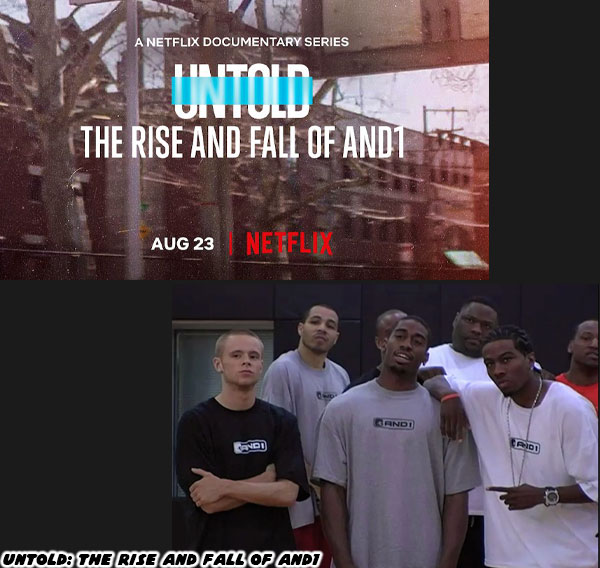
Over the next few days I am going to try and make sense of the streetball world and figure out where it has been, where it is and where it is going. I hope there are a few things we can learn from these four parts.
Let's get off on the right foot and break down what exactly streetball is. For the most part, street basketball, and playground basketball are just basketball played with more freedom, flair and creativity. Nobody in the city ever says "let's go play streetball" instead it has always been "let's go play basketball."
Hopefully you also know that there is a difference between freestyle basketball, and streetball. Streetball is a creative form of basic basketball. Where style is almost as important as scoring. Crossovers, tricks, explosive dunks, many of these things just come out during the game of streetball. The job of the player is to score or pass for a score, it always has been and it always will be. If they can bounce the ball off some fool's head or throw it between their legs along the way to scoring then it's just icing on the cake. In the street game sometimes a player can get away with carrying or doing tricks that are illegal in a pro league, other times a player is called on it and forces a turnover.
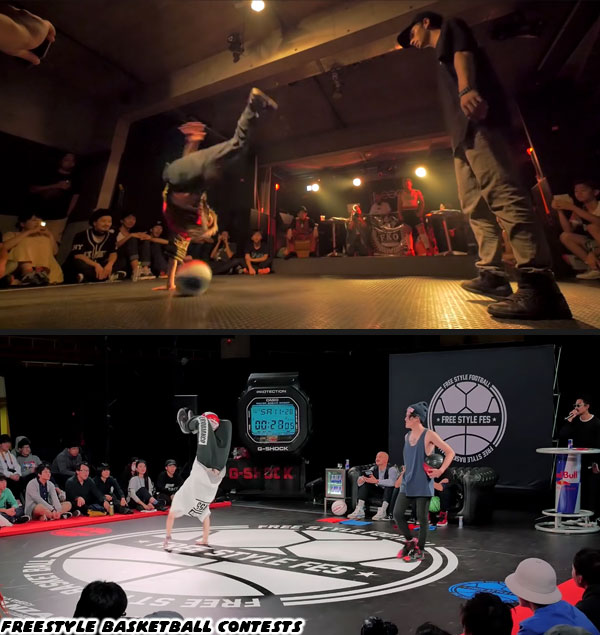
Streetball and basketball in general has become synonymous with Hip Hop, not because of the fashion or the rappers, but because the game as we know it grew out of the same neighborhoods in New York at the same time as Hip Hop. Both have the battle atmosphere, music and cultural points of reference. So make sure in your mind that you know the difference between streetball and freestyle basketball.
Unfortunately the modern state of Hip Hop has also corrupted the game. Real Hip Hop is a culture; it's about the music (DJ and MC), the dance, the graffiti, and knowledge. Just like Real Streetball is about the game, building a name, a rep and a legacy. In both Real Hip Hop and Streetball money is not the goal. A real Hip Hop artist isn't measured by wealth or fame but by how much they contribute to the culture. Real Streetball Legends aren't measured by TV commercials, mix tapes or tours, but by how great they are as basketball players, who they beat and how long their legacy was. Nowhere in the definition of a Real Streetball Legend do they measure their success by how many material possessions they have, not by how much ice they hang around their necks, the throwback jerseys they own, cars and mansions they floss or parties they go to. Being a real streetball player and legend is sort of the opposite message of what the videogame NBA Ballers is trying to sell.
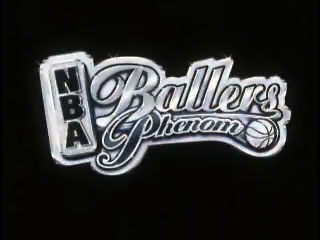
A word of warning for people or companies trying to sell you "the rules" of streetball. Such as a book written by AND 1 titled Streetball: All the Ballers, Moves, Smack and Rules You should be wary of anybody trying to package the game and convince you that they are the "official" anything of streetball. For now just keep your eyes and ears open. Streetball is all about basketball freedom. The game goes back to the first basket hung in the inner city. The basketball games in the early or golden-era of streetball circa 1960-1970 was the basis for the modern game and culture. Basketball courts became the stuff of legend and the players became playground gods. Why is this?
Inner-city life has always been hard in every major metropolis. Kids growing up in the city had to deal with a thousand other people just like them, knew the same people, liked the same things and even had the same name. The game was one way to break out and become somebody unique. Many of the young basketball players in the golden-era didn't have a promising future. Higher education was out of the question for a lot of them. Nobody in their families went to college, and good work was few and far between. So like their friends and neighbors they hustled day-to-day just to get by. Basketball was one way to hustle and one way to escape this existence.
You might still be able to find the previous SLAM presents "Streetball" issue in stores (with Stephon Marbury on the cover). The new issue is out now with Baron Davis on the cover.
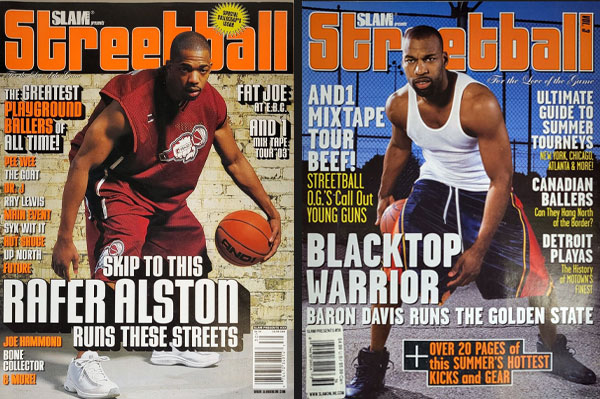
If you don't have a copy I'd suggest picking it up right away. If has a very good listing of the playground gods and small bits on their game. Sure the magazine could have been a hundred times bigger, but we take what we can get.
The playground game has always been very raw. If you came from a different neighborhood or borough you could expect to play some hard streetball. Ribs busted, elbows to the face, there was no mercy on the street. But playing those tough games and winning meant that players earned a reputation, if they kept fighting and winning games they eventually earned respect. Then there were players that were so good they didn't need to become bruisers to dominate on the court. These players became the stuff of legend. They could dribble, they could pass, shoot, defend, dunk and score at will. Best of all they did it with style. The game on the street was less organized and freer flowing. Creative is one word that comes to mind; it's the one thing that seems to have been eliminated in the pro ranks. These playground gods proved that they were great players and also great entertainers, unlike those in the league.
Even more unlike those in the league these playground legends had more respect because they came from and still lived in the 'hood. No matter how famous a player got, no matter how much money he could hustle from the game (or as many others did by selling drugs on the side) they would always come back home. Back to the inner city, back to the old neighborhood. They would bring that respect to their communities and the love became whole. Here's a quick look at some of these places and players.
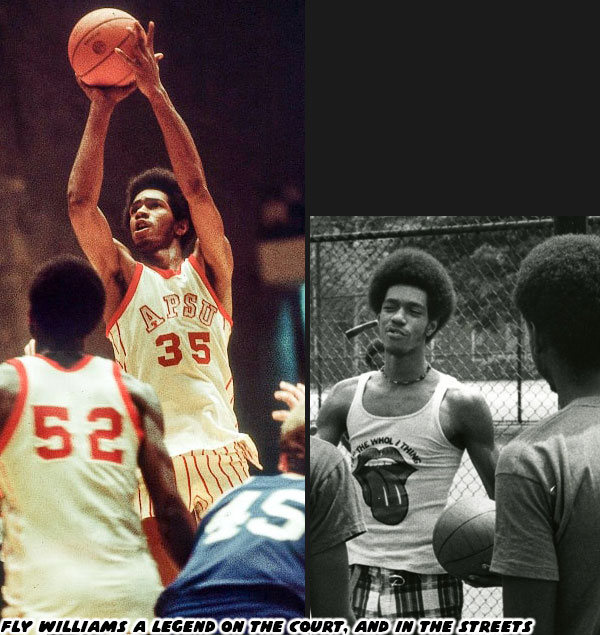
The game was so free, so creative, so original back then. But slowly it started to change. They say that money is the root of all evil. Money eventually began changing (some say corrupting) the game that was once free to the world. It didn't happen overnight. A little bit at a time, piece by piece, the players, the courts and the game were taken apart, packaged and sold. True playground basketball is rare now. Unless somebody has a camcorder running, or a contract, very few big names in streetball will even get out on the court.
"For the love of the game."
That's a slogan that only the hungry live by now. These are the true streetball players. If you want to see what real streetball is about now you have to go to the local playgrounds and participate. The games are fast-paced and tough. The players aren't doing it for the hopes of getting discovered or filmed. They play the game just to play the game. Many of these players are jaded because their game and culture is being marketed and sold. Many are also proud of their friends and family that were able to make a decent living playing the street game. The street game is a double-edged sword, if a player is good enough or famous enough things will start happening, but it might not be the respect or financial stability they were looking for. Instead it might be a never-ending circle of exploitation for the gain of others.
A big contributor to the evolution of streetball has been AND1. Their Mix Tape series seemingly sprung up overnight, and caused a cultural revolution. It didn't really happen overnight but took most of the 90's to become established. I'm not going to go into detail about who or what caused this, you can read all about it from this Complex interview with the players themselves.
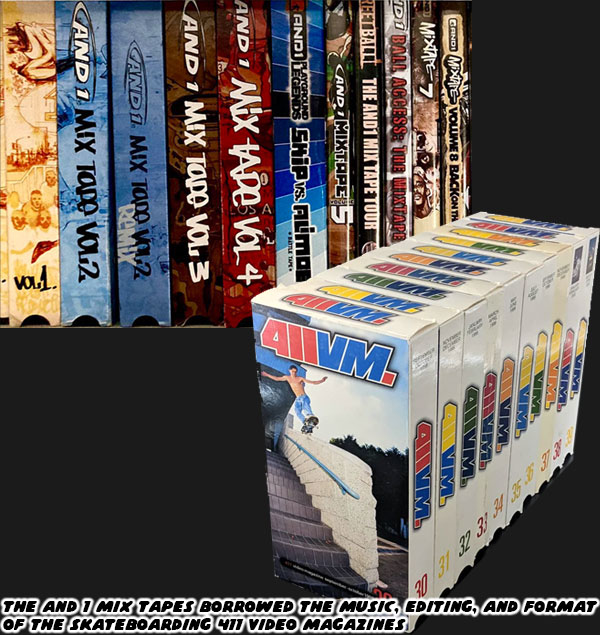
The players highlighted in the mix tapes were regular people, neighbors, that could play almost as good as the best NBA players. However they didn't have million-dollar contracts or fly from game to game in a private jet. Many still lived at home and rode the bus to the courts. For the first time average people that never cared much for the pro league were impressed with the skill, and talent that the mix tapes featured. The mainstream audience was becoming hooked on street players without calling themselves basketball fans in the first place.
Many believe that the world after the mix tapes was forever changed for the better. The only problem was that we would very shortly be getting mixed messages from the basketball and entertainment industry. This information (or misinformation) would have to be sorted out...
Did you ever play basketball? Or any basketball video games? Were you a fan of the Mix Tape Tour, or freestyle basketball? Or is this the first time you're hearing about it? Let me know in the comments section please. As always if you would like to sponsor me please visit my Patreon page and consider donating each month, even as little as $1 would help make better blogs and even podcasts!

No comments:
Post a Comment